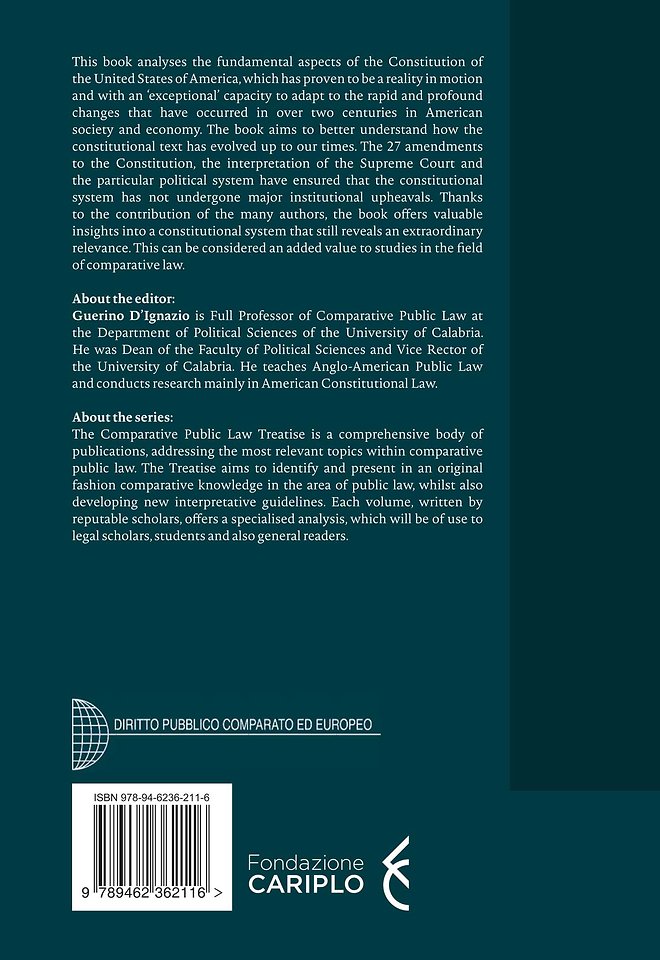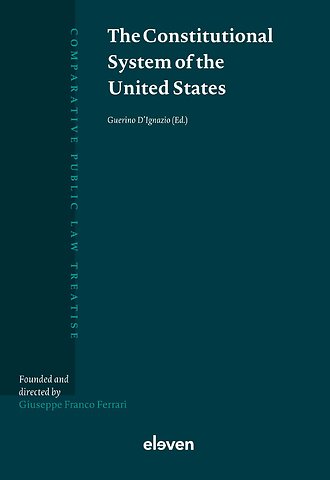



Guerino D’Ignazio is Full Professor of Comparative Public Law (IUS / 21) at the Department of Political and Social Sciences of the University of Calabria.
Meer over Guerino D'IgnazioThe Constitutional System of the United States
Gebonden Engels 2021 1e druk 9789462362116Samenvatting
This book analyses the fundamental aspects of the Constitution of the United States of America, which has proven to be a reality in motion and with an ‘exceptional’ capacity to adapt to the rapid and profound changes that have occurred in over two centuries in American society and economy.
The book aims to better understand how the constitutional text has evolved up to our times. The 27 amendments to the Constitution, the interpretation of the Supreme Court and the particular political system have ensured that the constitutional system has not undergone major institutional upheavals.
Thanks to the contribution of the many authors, the book offers valuable insights into a constitutional system that still reveals an extraordinary relevance. This can be considered an added value to studies in the field of comparative law.
Trefwoorden
amerikaans staatsrecht constitutioneel recht amerikaanse politiek grondwet federalisme constitutionalisme scheiding der machten vergelijkend staatsrecht rechterlijke macht grondrechten rechtsstaat amerikaanse geschiedenis democratie checks and balances supreme court congres president politiek systeem amendementenrecht burgerrechten openbaar bestuur wetgeving staatsrecht rechtspraak veto impeachment staatstheorie kiesrecht
Trefwoorden
Specificaties
Lezersrecensies
Inhoudsopgave
U kunt van deze inhoudsopgave een PDF downloaden
Claudio Martinelli
1.1 Colonial Roots of the American Constitutionalism 1
1.2 The Constitutional Value of the Declaration of Independence 3
1.3 The Confederal Transition 5
1.4 The Foundation of the Constitutional Order 7
1.5 The Territorial Enlargement of the Federal State 13
1.6 From the Civil War to a Global Power Role: Issues on a Political and Juridical Transformation 14
2 The Challenge of Formal Amendment in the United States 19
Richard Albert
2.1 An American Idea 19
2.2 The Basic Design of Article V 19
2.3 Formal Unamendability in the United States Constitution 21
2.4 Constructive Unamendability in the United States Constitution 22
2.5 The Non-Use of Article V 24
2.6 The Consequences of Amendment Difficulty 29
2.7 The Parochial Uses of Article V 30
2.8 The Variable Difficulty of Article V 32
Introductory Note to the Form of Government 35
Guerino D’Ignazio
3 Design, Evolution and Interpretation of Checks and Balances in the American Constitution 39
Andrea Buratti
3.1 Checks and Balances in the Design of the Framers and in the American Constitutional Experience 39
3.1.1 The Idea of Balance in the American Constitutional Culture 39
3.1.2 Checks and Balances in the Vision of the Framers 41
3.1.3 The Role of Checks and Balances in the Evolution of the American Constitution 43
3.2 Veto Power 43
3.2.1 Veto Power at the Dawn of the American Constitutional Experience 44
3.2.2 Veto Power at the Philadelphia Debates 45
3.2.3 Transformation of Veto Power in the Transition toward the Modern Presidency 47
3.2.4 The Pocket Veto between Case Law and Practice 49
3.2.5 The Role of Veto Power in the Lawmaking Process 51
3.2.6 The Spontaneous Formation of Checks and Balances: The Legislative Veto 53
3.2.7 Means of Presidential Review of Spending Bills: The Impoundment 55
3.2.8 The Line-Item Veto and Clinton v. City of New York (1998) 56
3.2.9 The Decrease of the Veto in Recent Presidencies and the Growth of Signing Statements 57
3.3 Impeachment 58
3.3.1 The Origins of Impeachment in the American Tradition 59
3.3.2 The Philadelphia Compromise 59
3.3.3 The Interpretation of Impeachment in Congressional Practice 61
3.3.4 The Exclusion of Judicial Review of Impeachment 62
3.3.5 The Gradual Definition of Presidential Legal Responsibility and the Development of the Doctrine of Presidential Immunity 63
3.4 Advice and Consent 64
3.4.1 The Origins of Advice and Consent 65
3.4.2 The Debate at the Convention 65
3.4.3 The Definition of ‘Officer of the United States’ 66
3.4.4 The Dialectic between Majority and Opposition 68
3.4.5 Recess Appointments and Supreme Court Case Law 69
3.4.6 Advice and Consent on International Treaties 70
3.4.7 International Treaties and Executive Agreements 70
3.5 Checks and Balances between Political Transformations and Constitutional Interpretation: The Role of the Supreme Court 72
4 Congress 75
Davide De Lungo
4.1 Historical Precedents 75
4.2 Political and Theoretical Framing of the Debates Held during the Philadelphia Convention 76
4.3 Products of the Philadelphia Convention 83
4.4 Powers and Limitations 89
4.5 Electoral System and Party Functions 100
4.6 Organization and Functioning 105
4.7 Legislative Function 109
4.8 Budget Approval Function 113
4.9 Information and Investigation Function 115
4.10 Oversight Function 116
4.11 The Senate’s Advice and Consent Function 119
5 The Public Administration in the System of Separation of Powers 121
Guerino D’Ignazio
5.1 The Characteristics of the Administrative State 121
5.2 The Constitutional Framework 123
5.3 Spoils System and Administrative ‘Democratization’ 124
5.4 The President’s Powers of Control 126
5.5 The Growth of the Administrative State and the New Organizational Models 128
5.6 The Executive Leadership 131
6 Sovereignty and Federalism 133
Andrea Pin & David Kenny
6.1 Introduction 133
6.2 From State Sovereignty to the Federation of the United States: The Role of the American Constitution 134
6.2.1 The Articles of Confederation and the Federal Constitution 134
6.2.2 State Immunity and Criminal Prosecution 137
6.3 Slavery, the Civil War and the Reconstruction 139
6.4 The New Deal and the Direct Election of the Senate 143
6.5 ‘Incorporation’ and Civil Rights 145
6.6 The New Federalism 147
6.7 Conclusion 151
7 Federalism and the Welfare State 155
Andrea Pierini
7.1 The Relationship between Federalism and the Welfare State in American Constitutional Law 155
7.2 Dual Federalism as the Expression of the Liberalism of the U.S. Constitution: The Connection to Laissez-Faire Constitutionalism 159
7.3 The New Deal and Cooperative Federalism 163
7.4 The Growing Role of the Federal Government: The Grants System 167
7.5 Continuing Limitations and Gaps in U.S. Welfare Protections Owing to the Lack of Constitutionalization of Welfare Rights 172
7.6 The New Federalism: A Reform Program Aimed at Dismantling the Welfare State by Reducing the Powers of the Federal Government 176
7.7 The Opposing Push towards Expanding the Welfare State and the Role of the Federal Government: Obamacare 181
7.8 Some Concluding Considerations 184
8 Fundamental Rights and Freedoms 187
Paolo Passaglia
8.1 Introduction 187
8.2 The Rights Recognized in Article I of the Constitution 187
8.3 Freedom of Expression 188
8.3.1 Religious Freedom 189
8.3.2 The Free Speech Clause 191
8.4 The Right to Keep and Bear Arms 193
8.5 Protection against Quartering of Soldiers 194
8.6 ‘Procedural’ Rights 194
8.6.1 Procedural Due Process of Law 195
8.6.2 Protection from Expropriation 196
8.6.3 Criminal Proceedings: Protection against Searches and Seizures 196
8.6.4 (Cont’d): Indictment of a Grand Jury 198
8.6.5 (Cont’d): Protection from Self-Incrimination 199
8.6.6 Double Jeopardy 200
8.6.7 Criminal Hearings: The Features of the Trial 201
8.6.8 (Cont’d): The Jury 202
8.6.9 (Cont’d): Equality of Arms between the Prosecution and the Defence 203
8.6.10 Civil Proceedings 204
8.7 Protection against Cruel and Unusual Punishment 205
8.8 Substantive Due Process 206
8.9 The Principle of Equality 209
8.9.1 The State-Action Doctrine 210
8.9.2 Racial Discrimination 210
8.9.3 Discrimination on Other Grounds 211
8.9.4 Affirmative Action 212
8.10 The Right to Vote 213
8.11 The Unenumerated Rights 214
9 The Supreme Court 215
Chiara Bologna
9.1 The Supreme Court throughout the History of the United States of America 215
9.2 Supreme Court Justices: Appointment, Status and Termination of Office 219
9.2.1 President and Senate in the Appointment and Confirmation of Supreme Court Justices 222
9.3 The judiciary and the Application of the Constitution: Marbury v. Madison 226
9.4 Gateways to the Court 229
9.5 Deciding Not to Decide: Certiorari, Justiciability and Political Questions 232
9.6 The Court That Decides: Majorities, Opinions and Types and Effects of Decisions 237
9.7 The Debate on Constitutional Interpretation 241
10 The Judicial System 247
Angioletta Sperti
10.1 Introduction 247
10.2 A Short Historical Account of the Judicial System of the States 248
10.3 General and Common Features of State and Federal Courts 253
10.4 The Structure of State Courts 254
10.5 The Structure of Federal Lower Courts 255
10.6 Subject-Matter Jurisdiction of Federal Courts and the ‘Doctrines of Justiciability’ 257
10.7 Selection of Judge, Term of Office and Removal 260
10.8 The Complexity of American Judicial Federalism and Judicial Policy-Making between State and Federal Courts and Legislatures 263
11 Protecting the Constitution against the States? The Importance of the ‘Guarantee Clause’ in a Comparative Law Perspective 267
Giuseppe Martinico
11.1 Introduction 267
11.2 Why a ‘Guarantee Clause’? The Fear Behind the Genesis of the Clause 269
11.3 What Do We Mean by ‘Republican Form of Government’? The Perspective of Constitutional Homogeneity 276
11.4 The Guarantee Clause as Piece of a Constitutional Puzzle 283
About the Authors 285
Anderen die dit boek kochten, kochten ook
Rubrieken
- advisering
- algemeen management
- coaching en trainen
- communicatie en media
- economie
- financieel management
- inkoop en logistiek
- internet en social media
- it-management / ict
- juridisch
- leiderschap
- marketing
- mens en maatschappij
- non-profit
- ondernemen
- organisatiekunde
- personal finance
- personeelsmanagement
- persoonlijke effectiviteit
- projectmanagement
- psychologie
- reclame en verkoop
- strategisch management
- verandermanagement
- werk en loopbaan





